The first thing I would like to point out is 100% of the babies’ feet that I’ve noticed including my six-year-old daughter’s are widest at the ends of the toes. So that’s a very important landmark to appreciate when fitting footwear.
Not so surprisingly, the children’s footwear for infants and toddlers to approximately age one will be shaped like a natural human foot. The truth is you’re going to be inundated with a lot of brands and a lot of selections out there.
However, it’s not that complicated to know what makes a shoe good and what makes it bad for your child’s foot health.

Features you need to consider
- Shoes should be foot-shaped.
- Shoes should be wide at the tips and quite flexible.
- Feet need to feel the ground.
- Barefoot is great.
- Flat heel or zero drop.
- Toes flat on the ground.
- Shoes Flexible and malleable.
 The first thing that you should take into account as a parent is to make sure that the shape of the shoe is the shape of your child’s natural foot.
The first thing that you should take into account as a parent is to make sure that the shape of the shoe is the shape of your child’s natural foot.
The second thing that you want to appreciate is for the normal development of your child, their foot needs to sense their environment very much like their hands need to sense their environment, which is to say that the only thing that is required for the child’s foot in this stage of development is a thin covering.
It’s completely appropriate to be fully barefoot or in stocking feet around the home. When you go outside or when the child is out playing though it’s completely appropriate just to add a thin layer of protecting material such as this light moccasin.
Quite frankly, that’s all the protection your child’s feet need. This way, your child is going to start gaining sensory information from their environment that will help their brain to develop their nervous system.
As they start to get a little bit older, kids’ footwear starts to get a little more built up. However, we still have the same goals and we still desire for the footwear not to have an elevated heel on it. In other words, we want our kids’ footwear to be flat; another footwear industry term you might read often is “zero drop”.
Notice that the shoe below is completely flat with no heel and that the child’s toes can be completely level and flat on the ground. Also notice that the toe box is widest at the end and not at the ball. And to satisfy our fourth feature, this is a flexible malleable shoe which is not going to hamper the development of that child’s foot sensing the ground. So when you’re in the store, those are the four things to start looking into. As the children get a little bit older, same things are still going to apply. You still want that flat shoe, you want the shoe to be malleable.

What To Avoid or Minimize
- Toe taper.
- Heel wedge.
- Toe spring.
- Rigidity of the outsole.
The model below is widest at the ball and not at the ends of the toes. When we put this model on the side profile, you’ll see that the heel is slightly higher than the front of the foot. Also, in this model the child’s toes are placed higher and up in the air. This is technically called “toe spring”. Toe spring prevents the toes from, again, gaining sensory information from the ground, and for that reason the toes should all be down level against the support surface.

Another downside you’ll notice is this model’s outsole is on the rigid side, and if you want to twist it there’s no movement whatsoever. It would be like putting our child in a cast. Unfortunately, this will hamper the development of your child’s foot.
How do I check fit and compare shoes?
Pull out the sock liner, also known as the insole, and place your child’s foot on top of the sock liner. This should be the fitting guide for the child. The sock liner in the picture is widest at the ball of the foot and a bit narrow at the front, which means that this shoe will begin to shape your child’s foot in the direction of a bunion and a tailor’s bunion. The foot will be tapered or deformed into the tapered shape of the toe box.

The second model also has a generous amount of toe spring where the toe box will be holding the ends of the toes approximately 25 to 30 degrees above the support surface. Some shoes will have this feature built-in but it will be flexible enough that it will bottom out when the child walks on this shoe. But this is not such an example as even though I’m applying some pretty significant force to the shoe, the toe box does not go back down to the ground.
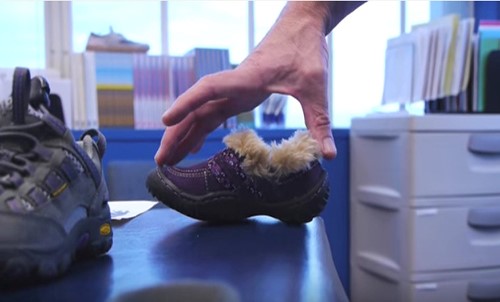
There are other models out there such as the model below that have a built-in toe splay which bottoms out pretty easily. When kids wear this type of shoe, very little amount of body weight is required to actually flatten out the shoe.
So to answer your question as parents if the shoe has little bit of toe spring while you’re looking at it in the store, just put your child’s foot in the shoe and have them stand in front of you. If you notice that the toe spring bottoms out, you’re probably going to be OK. It’s the rigid toe spring that no amount of pressure is going to bring that toe box down to the ground that’s going to onset the crippling process at your child’s tender age that will develop into chronic foot problems at a variable later age in life.


Compare this to another foot-shaped shoe which is very flexible with a negligible heel. When we put it on a flat surface there’s no toe spring as we saw with the other model. If we remove the sock liner of this shoe and stack it alongside of the shoe that we just looked at, this particular model will enable that child’s foot to be widest where a natural foot should be widest. The toe box is wider through the ends of the toes. I would encourage parents to purchase a shoe like this as it is more in keeping with natural foot development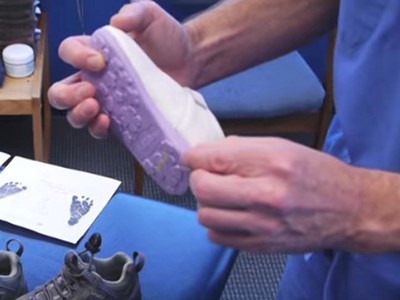
Quote: “If toe spring yields, it’s OK”
What if a shoe doesn’t feature a removable insole?
In the store, superimpose the shoe upside down and superimpose your child’s foot on top of the sole. You would again want to see your whole child’s foot on the outsole and not splaying beyond it because the upper part of the shoe is going to be a little bit narrower on the sole.
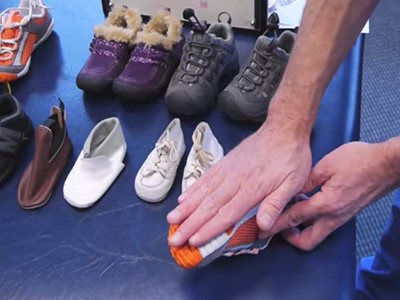
Quote “Most foot problems are caused by ill-fitting footwear”
About The Author
My name’s Eric Barber. Being raised by a podiatrist father made my whole life evolve around feet and foot health. Check out my blog steadyfoot.com for more detailed footwear reviews, running tips and other gear reviews.
 Kaboutjie SA Mommy Blogs by Lynne Huysamen
Kaboutjie SA Mommy Blogs by Lynne Huysamen

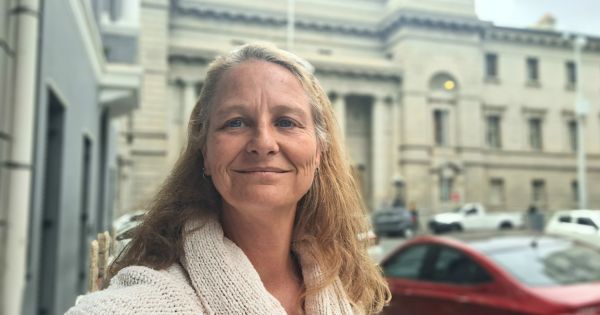
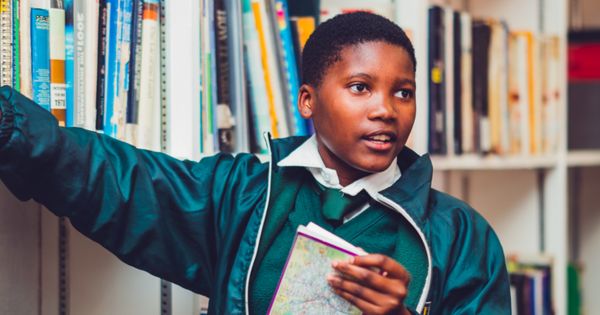
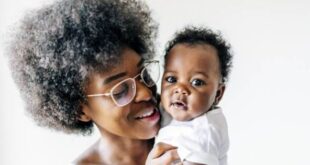

I appreciate this article. My oldest son’s left foot turns in quite badly. It always has but I was told it would go away after a certain age … now it’s worse and I’m not sure if it’s because of shoes. He’s always barefoot except for school where he has to wear white trainers so I guess it’s probably not shoe related but it’s still good to know what to look for when buying shoes for kids.
I struggled to find good shoes for my kids when they were babies. It was either that all the shoes were very badly designed… or my kids feet were really fat. I suspect that I just struggled to find decent shoes. It seems there is a big gap in the market, the shoes for babies in the retail shops I came across were mostly rigid and hard.
I love the flexible sole shoes for babies, the Pitta Patta type shoes are brilliant because baby can move his or her feet without any problems. My babies wore Pitta Patta or went bare foot.
@lynne, I myself love being barefoot – if I didn’t have to wear shoes, I really wouldn’t bother.
So when I gave birth to my little one, I carried that philosophy with me. We went into her first summer when she was 2.5 months old. My child was barefoot always or perhaps just a pair of socks. Personally I feel it helped with her walking as she was walking by 9 months. I could be wrong but I feel having no material between her feet and the ground helped her learn balance and when she started she was a-for-away. She has developed a bit of a shoe fetish the last year or so and now refuses to leave the house without shoes (which is fine – it’s her call) but the minute she gets home they come off. Just like me. Yesterday we had a meeting with her teacher at school and she brought up the fact that my little one prefers to be barefoot than wear her shoes and socks. For me, no big deal right? Her teacher then proceeded to tell me that it may be an indication of sensory issues? I was gobsmacked. My little one is also not a fan of dirt – at all. Since she was tiny, if her hands were dirty she would have a little freak out lol, but saying that, I am exactly the same, I just don’t like mess or being dirty. So now the whole barefoot thing and the dirt thing has lead my daughters teacher to suggest occupational therapy.
So now its left me pondering if letting her run around barefoot and be a child, was in-fact the right call?
Reading this post makes it so much easier to buy shoes.
Ive also seen shoes for the first year is totally a waist of money. We have like 7 new pairs that is way to small now as a baby dont wear shoes, well not our boy.
Also something i have seen alot now. Budget-savvy parents sometimes attempt look ahead and purchase shoes that are just a little too big for their children so the kids can wear them longer. This likely backfire, as the problems associated with wearing footwear that is too large can be more troublesome or even unsafe than what the small savings are worth. Plus, the sound of too-large shoes slapping on your hard floors may be enough to drive you absolutely crazy.
Also buying second hand shoes a no-go!!
Thanks for sharing this great article Lynne.
This is a very informative and are completely relevant to most parents.
When JD was a baby I didn’t even bother with shoes because a baby grow so quickly, it’s practically useless spending money on shoes.
He wore socks or went barefoot most of the time.
Last Winter he wore socks or baby grows which wasn’t a problem because he was only one year old.
His first shoes I bought him was sandals, the one’s that has the adjustable vinyl. These were the only shoes that were comfortable and fitted him well. The arch of his foot is quite high therefore most sandals or other shoes is not a great fit. And when I buy shoes, I’ll rather spend a bit more and buy shoes that last at least a few months.
JD loves being barefoot but he also loves putting on his shoes, depending on his mood. 🙂
We went shoe shopping two weekends ago with Winter around the corner.
I bought him his first pair of Ugg boots and a pair of tekkies. I must say both fits him very well and is super comfortable.
I wasn’t too sure which shoes would be best but I opted for comfort and I’m happy to see now that I’m reading this post that they do contain some of the features one should be looking for.